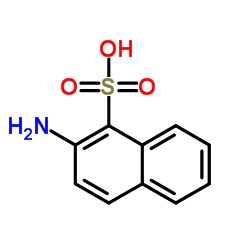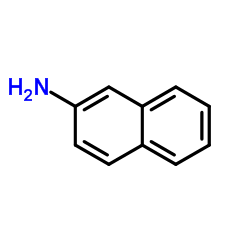2-Naphthylamine-1,5-disulfonic acid

2-Naphthylamine-1,5-disulfonic acid structure
|
Common Name | 2-Naphthylamine-1,5-disulfonic acid | ||
|---|---|---|---|---|
| CAS Number | 117-62-4 | Molecular Weight | 303.312 | |
| Density | 1.8±0.1 g/cm3 | Boiling Point | N/A | |
| Molecular Formula | C10H9NO6S2 | Melting Point | > 300ºC | |
| MSDS | N/A | Flash Point | N/A | |
| Name | 2-Amino-1,5-naphthalenedisulfonic acid |
|---|---|
| Synonym | More Synonyms |
| Density | 1.8±0.1 g/cm3 |
|---|---|
| Melting Point | > 300ºC |
| Molecular Formula | C10H9NO6S2 |
| Molecular Weight | 303.312 |
| Exact Mass | 302.987122 |
| PSA | 151.52000 |
| LogP | -0.43 |
| Index of Refraction | 1.733 |
| Water Solubility | soluble |
Synonym:2-Naphthylamine-1,5-Disulfonic Acid Section 2 - COMPOSITION, INFORMATION ON INGREDIENTS
Risk Phrases: 34 Section 3 - HAZARDS IDENTIFICATION EMERGENCY OVERVIEW
Causes burns.Corrosive. Potential Health Effects Eye: Causes eye burns. May cause chemical conjunctivitis and corneal damage. Skin: Causes skin burns. May cause skin rash (in milder cases), and cold and clammy skin with cyanosis or pale color. Ingestion: May cause severe and permanent damage to the digestive tract. Causes gastrointestinal tract burns. May cause perforation of the digestive tract. May cause systemic effects. Inhalation: May cause severe irritation of the respiratory tract with sore throat, coughing, shortness of breath and delayed lung edema. Causes chemical burns to the respiratory tract. Aspiration may lead to pulmonary edema. May cause systemic effects. Chronic: Effects may be delayed. Section 4 - FIRST AID MEASURES Eyes: Get medical aid immediately. Do NOT allow victim to rub eyes or keep eyes closed. Extensive irrigation with water is required (at least 30 minutes). Skin: Get medical aid immediately. Immediately flush skin with plenty of water for at least 15 minutes while removing contaminated clothing and shoes. Wash clothing before reuse. Destroy contaminated shoes. Ingestion: Do not induce vomiting. If victim is conscious and alert, give 2-4 cupfuls of milk or water. Never give anything by mouth to an unconscious person. Get medical aid immediately. Inhalation: Get medical aid immediately. Remove from exposure and move to fresh air immediately. If breathing is difficult, give oxygen. Do NOT use mouth-to-mouth resuscitation. If breathing has ceased apply artificial respiration using oxygen and a suitable mechanical device such as a bag and a mask. Notes to Physician: Section 5 - FIRE FIGHTING MEASURES General Information: As in any fire, wear a self-contained breathing apparatus in pressure-demand, MSHA/NIOSH (approved or equivalent), and full protective gear. During a fire, irritating and highly toxic gases may be generated by thermal decomposition or combustion. Extinguishing Media: In case of fire, use water, dry chemical, chemical foam, or alcohol-resistant foam. Section 6 - ACCIDENTAL RELEASE MEASURES General Information: Use proper personal protective equipment as indicated in Section 8. Spills/Leaks: Avoid runoff into storm sewers and ditches which lead to waterways. Clean up spills immediately, observing precautions in the Protective Equipment section. Sweep up, then place into a suitable container for disposal. Avoid generating dusty conditions. Provide ventilation. Section 7 - HANDLING and STORAGE Handling: Use only in a well-ventilated area. Minimize dust generation and accumulation. Do not breathe dust, vapor, mist, or gas. Do not get in eyes, on skin, or on clothing. Keep container tightly closed. Do not ingest or inhale. Discard contaminated shoes. Storage: Keep container closed when not in use. Store in a cool, dry, well-ventilated area away from incompatible substances. Corrosives area. Section 8 - EXPOSURE CONTROLS, PERSONAL PROTECTION Engineering Controls: Facilities storing or utilizing this material should be equipped with an eyewash facility and a safety shower. Use adequate ventilation to keep airborne concentrations low. Exposure Limits CAS# 117-62-4: Personal Protective Equipment Eyes: Wear appropriate protective eyeglasses or chemical safety goggles as described by OSHA's eye and face protection regulations in 29 CFR 1910.133 or European Standard EN166. Skin: Wear appropriate protective gloves to prevent skin exposure. Clothing: Wear appropriate protective clothing to prevent skin exposure. Respirators: A respiratory protection program that meets OSHA's 29 CFR 1910.134 and ANSI Z88.2 requirements or European Standard EN 149 must be followed whenever workplace conditions warrant respirator use. Section 9 - PHYSICAL AND CHEMICAL PROPERTIES Physical State: Powder Color: beige Odor: None reported. pH: Not available. Vapor Pressure: Not available. Viscosity: Not available. Boiling Point: Not available. Freezing/Melting Point: > 300 deg C Autoignition Temperature: Not applicable. Flash Point: Not applicable. Explosion Limits, lower: Not available. Explosion Limits, upper: Not available. Decomposition Temperature: Solubility in water: soluble Specific Gravity/Density: Molecular Formula: C10H9NO6S2 Molecular Weight: 303.29 Section 10 - STABILITY AND REACTIVITY Chemical Stability: Stable under normal temperatures and pressures. Conditions to Avoid: Incompatible materials, dust generation, excess heat, strong oxidants. Incompatibilities with Other Materials: Strong oxidizing agents. Hazardous Decomposition Products: Nitrogen oxides, carbon monoxide, oxides of sulfur, carbon dioxide, nitrogen. Hazardous Polymerization: Has not been reported. Section 11 - TOXICOLOGICAL INFORMATION RTECS#: CAS# 117-62-4: QJ6135000 LD50/LC50: CAS# 117-62-4: Draize test, rabbit, eye: 20 mg/24H Moderate; Draize test, rabbit, skin: 500 mg/24H Mild; Oral, rat: LD50 = 5430 mg/kg. Carcinogenicity: 2-Amino-1,5-Naphthalenedisulfonic Acid - Not listed by ACGIH, IARC, or NTP. Other: See actual entry in RTECS for complete information. Section 12 - ECOLOGICAL INFORMATION Section 13 - DISPOSAL CONSIDERATIONS Dispose of in a manner consistent with federal, state, and local regulations. Section 14 - TRANSPORT INFORMATION IATA Shipping Name: CORROSIVE SOLID, N.O.S.* Hazard Class: 8 UN Number: 1759 Packing Group: III IMO Shipping Name: CORROSIVE SOLID, N.O.S. Hazard Class: 8 UN Number: 1759 Packing Group: III RID/ADR Shipping Name: CORROSIVE SOLID, N.O.S. Hazard Class: 8 UN Number: 1759 Packing group: III Section 15 - REGULATORY INFORMATION European/International Regulations European Labeling in Accordance with EC Directives Hazard Symbols: C Risk Phrases: R 34 Causes burns. Safety Phrases: S 26 In case of contact with eyes, rinse immediately with plenty of water and seek medical advice. S 28A After contact with skin, wash immediately with plenty of water. WGK (Water Danger/Protection) CAS# 117-62-4: 1 Canada CAS# 117-62-4 is listed on Canada's DSL List. CAS# 117-62-4 is listed on Canada's Ingredient Disclosure List. US FEDERAL TSCA CAS# 117-62-4 is listed on the TSCA inventory. SECTION 16 - ADDITIONAL INFORMATION N/A |
CHEMICAL IDENTIFICATION
HEALTH HAZARD DATAACUTE TOXICITY DATA
|
| Hazard Codes | C:Corrosive; |
|---|---|
| Risk Phrases | R34 |
| Safety Phrases | S26-S28A |
| RIDADR | 1759 |
| WGK Germany | 2 |
| RTECS | QJ6135000 |
| Packaging Group | III |
| Hazard Class | 8 |
| HS Code | 2921499090 |
|
~% 
2-Naphthylamine... CAS#:117-62-4 |
| Literature: Journal fuer Praktische Chemie (Leipzig), , vol. <2> 103, p. 135,136, 151, 153 |
|
~% 
2-Naphthylamine... CAS#:117-62-4 |
| Literature: Chem. News J. Ind. Sci., , vol. 62, p. 163 |
|
~% 
2-Naphthylamine... CAS#:117-62-4 |
| Literature: Chem. News J. Ind. Sci., , vol. 73, p. 55 |
|
~% 
2-Naphthylamine... CAS#:117-62-4 |
| Literature: Chem. News J. Ind. Sci., , vol. 62, p. 163 |
| Precursor 3 | |
|---|---|
| DownStream 8 | |
| HS Code | 2921499090 |
|---|---|
| Summary | 2921499090 other aromatic monoamines and their derivatives; salts thereof VAT:17.0% Tax rebate rate:9.0% Supervision conditions:none MFN tariff:6.5% General tariff:30.0% |
| 2-Aminonaphthalene-1,5-disulfonic acid |
| MFCD00021512 |
| D SALT |
| Sulfonic Tobias Acid |
| EINECS 204-201-6 |
| 2-AMINO-1,5-NAPHTHALENE-DISULFONIC ACID |
| 1,5-Naphthalenedisulfonic acid, 2-amino- |
| 2-Naphthylamine-1,5-disulfonic acid |
| SULFO TOBIAS ACID |
| 1,5-disulfo-2-aminonaphthalene |
| 2-aminonaphthalene-1,5-disulphonic acid |
| kyselinasulfo-tobiasova |
| 2-amino-1,5-naphthalenedisulfonic |
| 2-Amino-1,5-naphthalenedisulfonic acid |
| 2-amino-1,5-naphthalenedisulphonic acid |
| 2-amino-naphthol-1,5-disulfonic acid |
| 2-naphthylamine-1,5-disulphonic acid |
| SULPHOTOBIAS ACID |
| 2-amino-1,5-naphthalenedisulfonate |
| 2-amino-5-naphthalenedisulfonicacid |
| 5-sulfo-tobiasaci |




 CAS#:93-00-5
CAS#:93-00-5 CAS#:494-44-0
CAS#:494-44-0 CAS#:91-59-8
CAS#:91-59-8 CAS#:6535-70-2
CAS#:6535-70-2 CAS#:575-44-0
CAS#:575-44-0 CAS#:23894-12-4
CAS#:23894-12-4 CAS#:55524-84-0
CAS#:55524-84-0
